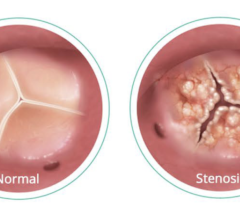
Increasing ketone supply to the heart in mice with heart failure with preserved ejection fraction (HFpEF) allowed their hearts to utilize more ketones and produce more energy, according to preliminary research presented by study author Qiuyu (Violet) Sun, B.Sc., a Ph.D. candidate at the University of Alberta in Canada. The findings were presented today during the the American Heart Association’s Basic Cardiovascular Sciences Scientific Sessions 2024. Image courtesy: American Heart Association/copyright Qiuyu (Violet) Sun
July 24, 2024 — Increasing ketone supply to the heart in mice with heart failure with preserved ejection fraction (HFpEF) allowed their hearts to utilize more ketones and produce more energy, according to preliminary research presented today at the American Heart Association’s Basic Cardiovascular Sciences Scientific Sessions 2024, BCVS. The meeting is in Chicago, July 22–25, 2024, and offers the latest research on innovations and discovery in cardiovascular science.
BCVS is one of the largest meetings in the world dedicated to fundamental and translational research to improve heart health, a goal that the pandemic has only made more critical. Presented by the American Heart Association’s Basic Cardiovascular Sciences Council, the 2024, in-person meeting features leading researchers in fields such as microRNAs, cardiac gene and cell therapy, cardiac development and also includes tissue engineering and iPS cells.
Study Summary
An overview of the study and its findings, released by the American Heart Association, is shared here, including the following research highlights:
In mice with heart failure with preserved ejection fraction (HFpEF), increasing ketone supply to the heart allowed their hearts to utilize more ketones and produce more energy.
Researchers hope this study may help to improve our understanding of the complex and different root causes of HFpEF from a metabolic perspective and potentially identify targets for development of medications to treat HFpEF.
Heart failure with preserved ejection fraction, a common type of heart failure, occurs when there are signs and symptoms of heart failure with a high left ventricle filling pressure despite normal or a near-normal left ventricle ejection fraction of 50% or higher. Heart failure with reduced ejection fraction is when the heart’s pumping power is 40% or less. A normal ejection fraction reading is between 50 to 70%. Heart failure with reduced ejection fraction (HFrEF) is well-studied and has established management plans and therapeutic strategies; in contrast, there is no current evidence-based treatment for HFpEF.
Healthy hearts require a high rate of adenosine triphosphate (ATP) production (provides the energy to drive and support the heart) to maintain their continuous pumping action. This energy comes from a balanced use of glucose and fats to support the heart’s contractile function.
“Ketones are a special energy resource,” said study author Qiuyu (Violet) Sun, B.Sc., a Ph.D. candidate at the University of Alberta in Canada. “Humans normally rely on carbohydrates and fat for energy. However, when blood glucose levels fall, such as after prolonged fasting or strenuous exercise, it poses a risk to our brain, which depends on glucose and cannot utilize fats for energy. To address this, our body has a built-in mechanism to produce this special energy substrate called ketones,” Sun added.
“This process is known as ketogenesis and involves breaking down fats from fat storage. The liver then converts these fats into ketone bodies, which enter the bloodstream to fuel the brain,” Sun explained. She added, “Ketones can convert the chemical energy in the form of ATP to improve the heart’s pumping ability in a continuous fashion.”
According to the researchers, relying on fatty acids to produce ATP could be problematic. Fatty acids are a less efficient fuel source compared to glucose because fats require more oxygen to produce the same amount of ATP as glucose.
In this study, researchers assessed mice hearts’ metabolism and found that hearts with HFpEF reconstructed their metabolic profiles. Specifically, the researchers found in HFpEF hearts, ketone use was impaired, as well was also an impaired glucose oxidation rate coupled with an increase in fatty acid oxidation. These two changes balance each other, leading to overall preserved energy production.
When HFpEF hearts were given more ketones, this resulted in an increase in overall ATP production coming from ketones and glucose oxidation to ATP from 15% to 28% with preserved pumping ability. So, increasing ketone supply to the heart in HFpEF mice led to higher ATP production.
“This is crucial because this increase in ketone use by the heart did not cause any interference with glucose or fat use. In other words, ketones were not competing with glucose or fats as the energy source. As such, elevated ketone oxidation does not further aggravate the disrupted metabolic profile of the heart in HFpEF,” Sun said.
According to the American Heart Association’s 2024 Heart Disease and Stroke Statistics, an estimated 56.2 million people were living with heart failure across 204 countries globally in 2019. However, this estimate likely underrepresents the true rate of heart failure because of data and diagnostic gaps in low-resource regions and countries.
“The prevalence of heart failure with preserved ejection fraction is rising, driven by an aging population and increasing obesity rates. Unfortunately, there is still a lack of clinically effective treatment for this condition,” Sun said. “We hope our study can help us better understand this condition. Identifying key proteins involved in cardiac energy metabolism could potentially lead to identification of druggable targets for future development of medications to treat HFpEF.”
Sun said the next steps are to investigate the precise role of ketone use by the heart in HFpEF and to assess whether increasing the ketone supply to the heart could potentially optimize heart energy production and lead to improved cardiac function.
The AHA/ACC/HFSA 2022 joint guideline for the management of heart failure calls for increased focus on preventing heart failure in people who are showing early signs of “pre-heart failure,” and updated treatment strategies for people with symptomatic heart failure to include SGLT-2 inhibitor (SGLT2i) medicines. SGLT-2 inhibitors are a class of prescription medicines that are FDA-approved for use with diet and exercise to lower blood sugar in adults with Type 2 diabetes.
Study background:
- In a lab setting, two groups of mice were used. The first experimental group of mice received a 60% high-fat diet and L-NAME (an inhibitor of nitric oxide synthesis) every day for 6 weeks to induce HFpEF. The second control group (HFpEF was not induced) were fed a low-fat diet and regular drinking water.
- The mouse hearts were removed and treated with two different levels of β-hydroxybutyrate and studied for how quickly the hearts used the major energy sources, such as glucose, fatty acids and ketones.
Study limitations were that it focused on the metabolic phenotype of HFpEF. However, there are different subgroups of HFpEF that possess varied clinical presentation, such as the fibrotic type or the diastolic dysfunction phenotypes of HFpEF. Both subgroups of HFpEF are of equal importance and should be investigated further. Additionally, because mice have different physiology and metabolic profiles than humans, future research should better characterize cardiac energy metabolism in HFpEF using experimental models that more closely align and translate to humans.
Co-authors, their disclosures and funding sources are listed in the abstracts. In addition, the organization noted that the study featured in this news release is a research abstract. Abstracts presented at American Heart Association’s scientific meetings are not peer-reviewed, and the findings are considered preliminary until published as full manuscripts in a peer-reviewed scientific journal.
More information: www.heart.org
Follow more American Heart Association news coverage by DAIC here.


 May 02, 2025
May 02, 2025 








